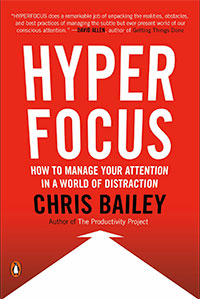
The point: Your ability to focus isn’t limitless and you need to consciously decide and set yourself up to tap into focusing when doing tasks that you cannot do out of habit. Hyperfocusing on our most complex, productive tasks lets us activate the most productive mode of our brains and get a large amount accomplished in a short amount of time.
Who is the book for: Anyone who is having difficulty getting through projects even when they really want to.
Key points:
There’s a finite limit to how many things we can focus on and that limit is smaller than you think. We can only focus on forty bits of information at a time.
We have an autopilot mode that guides us through actions that are habits. As many of 40 percent of our actions fall into this category and don’t require conscious deliberation.
It’s impossible to live intentionally 100 percent of the time. But some decisions are worth making deliberately. How we manage our attention is one of them.
If you’re in doubt about consuming something, ask yourself: How do you think your life will be different knowing this piece of information?
Notes:
How frequently do you choose what to focus on? In other words, roughly how much of your time do you spend deliberately and with intention, deciding in advance what you want to do and when you’ll do it?
Directing your attention toward the most important object of your choosing and then sustaining that attention is the most consequential decision we will make throughout the day. We are what we pay attention to.
There are two main criteria to consider when categorizing what to focus on: whether a task is productive (you accomplish a lot by doing it) and whether a task is attractive (fun to do) or unattractive (boring, frustrating, difficult, etc.)
Your most necessary and purposeful tasks can’t be done out of habit. This is exactly what makes these task so productive.
Hyperfocusing on our most complex, productive tasks lets us activate the most productive mode of our brains and get a large amount accomplished in a short amount of time.
Our energy levels influence how well we’re able to focus. With less sleep we focus for shorter durations of time, experience more negative moods, seek less demanding tasks and spend more time off task throughout the day.
Dots are pieces of information that we consume. Consuming information adjacent to what you’ve taken in before allows you to develop a constellation of dots around a single idea.
If you’re in doubt about consuming something, ask yourself: How do you think your life will be different knowing this piece of information?
Just as there are limits to how well we’re able to focus, the same can be said about how much information we can collect. While our brain has nearly limitless storage space, our attention is far more restricted. Focusing on useful information (typically actionable and helps you reach your goals) is far better than listening to random talking heads because that just sucks up time and wastes some of your “dots.”
Consume more useful information when we have the energy to process something more dense, consume balanced information when we have less energy; consume entertaining information with intention or when we’re running low on energy and need to recharge, and consume less trashy information.
Passively consuming pointless trash adds nothing to your life. Chose two items that don’t bring you genuine enjoyment and eliminate them entirely.
The brain needs a few minutes to switch between hyperfocus and scatterfocus. Therefore, taking scatterfocus breaks that are at least fifteen minutes long with yield better results that trying to take advantage of tiny chunks or time throughout the day.
Scatterfocus is the most creative mode of your brain. Just as with hyperfocus, it’s worth spending as much time as you possibly can practicing it.
As well as entering scatterfocus mode on work breaks, there are countless other opportunities to apply scatterfocus during the day: notice when you finish a task and use that as a cue to scatter your attention for a bit.
Developing happiness will allow you to focus more because a positive mood expands the size of your attentional space, regardless of which mode you’re in.
To boost happiness you can trying these suggestions: recall three things you’re grateful for, journaling about one good experience you had and meditating.
Hyperfocus is most effective during your peak energy times and scatterfocus is most powerful when you have the least energy.
Related Readings:
The Miracle Morning by Hal Elrod. By getting up early and practicing certain routines we set ourselves up to have really great days.
Atomic Habits by James Clear. Putting systems in place allows us to consistently implement small changes that lead to bigger changes over time.
Read my Book Notes on The Miracle Morning.
Read my Book Notes on Atomic Habits.
One thought on “Hyperfocus by Chris Bailey -Book Summary and Notes”